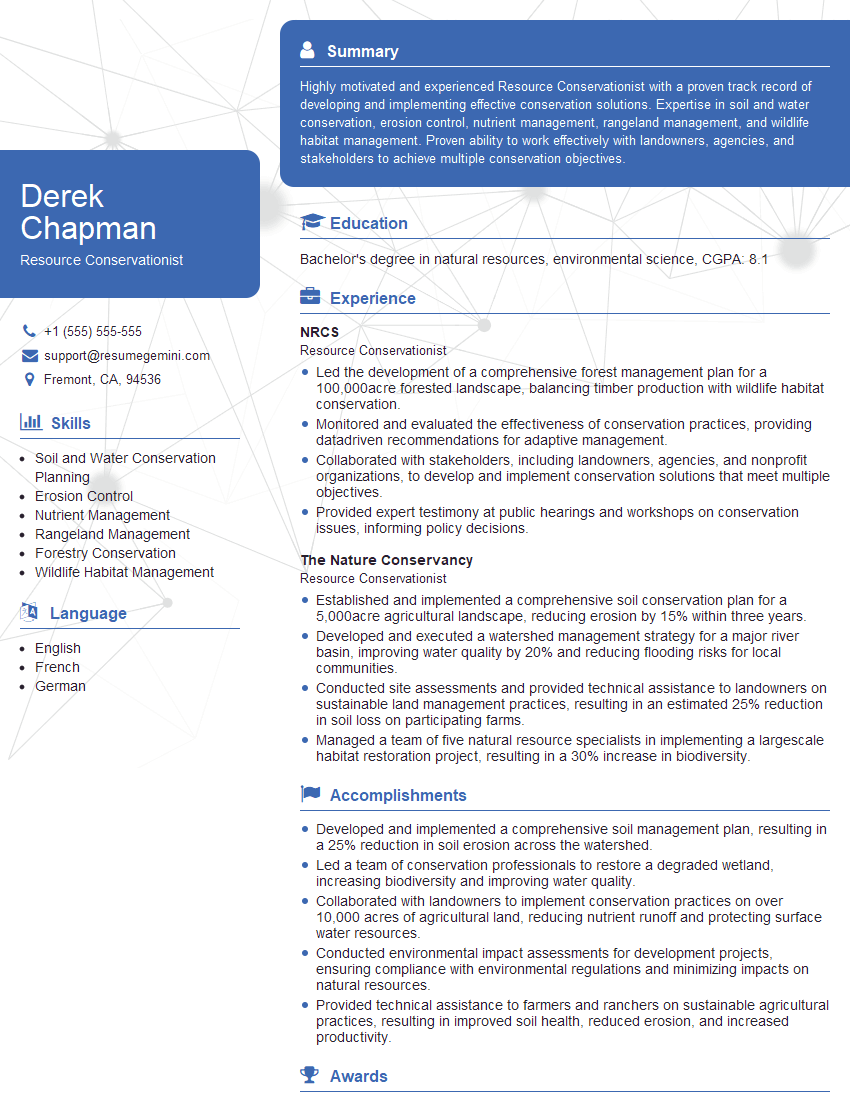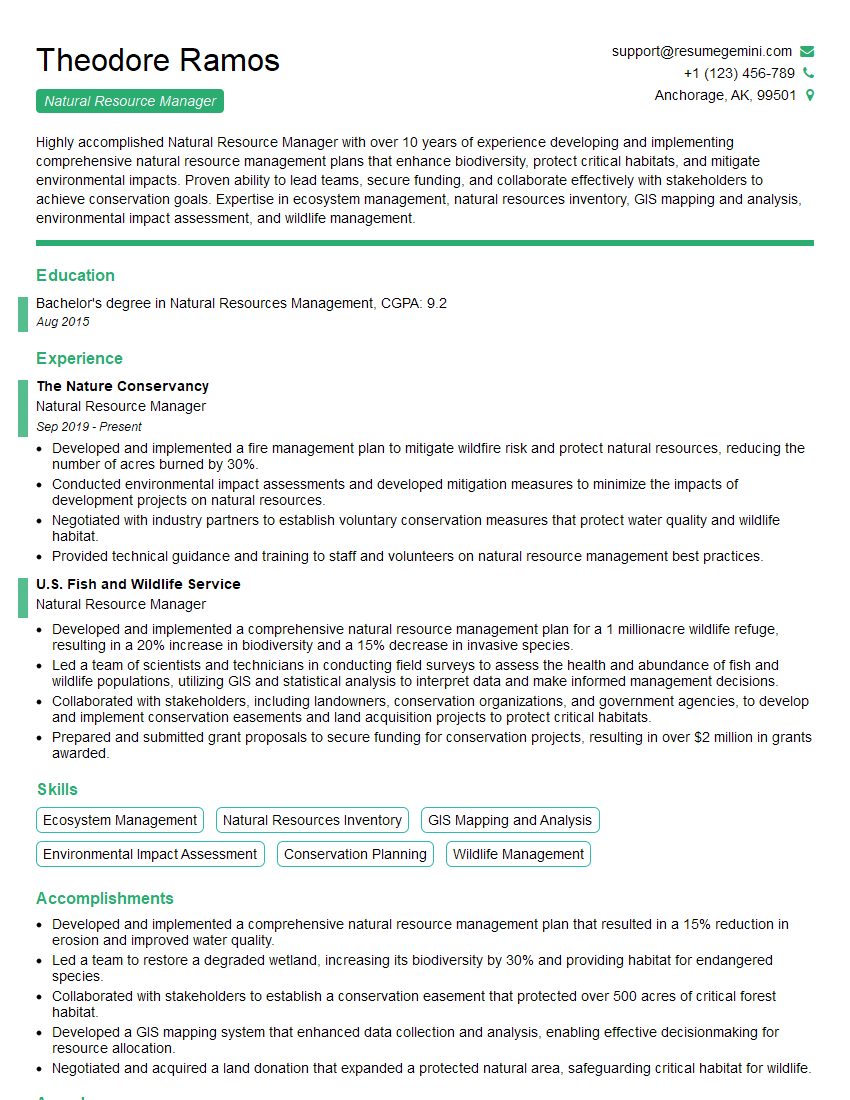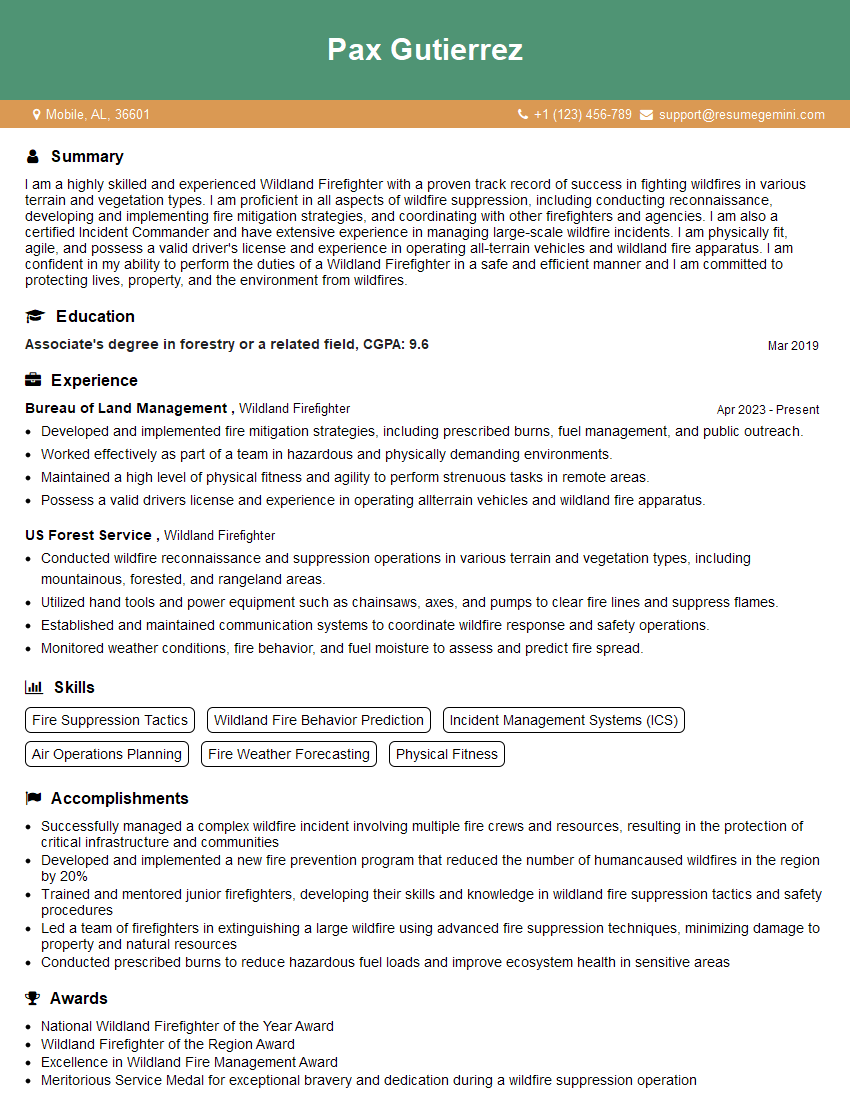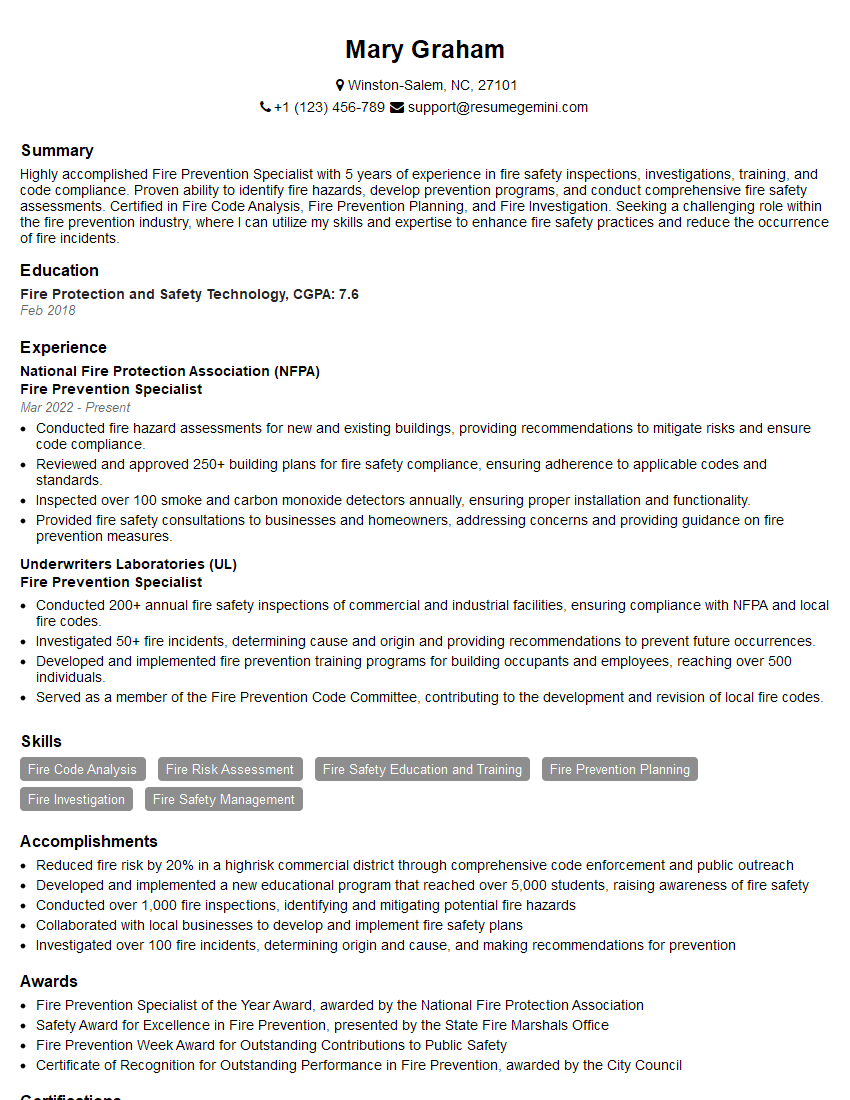Cracking a skill-specific interview, like one for Firebreak Cutting, requires understanding the nuances of the role. In this blog, we present the questions you’re most likely to encounter, along with insights into how to answer them effectively. Let’s ensure you’re ready to make a strong impression.
Questions Asked in Firebreak Cutting Interview
Q 1. Describe the different types of firebreaks.
Firebreaks are strategically constructed gaps in vegetation designed to stop or slow the spread of wildfires. They come in various types, each suited to different terrain and fuel conditions.
- Fuel Breaks: These are wider, more extensive breaks that often involve removing all or most vegetation. They’re designed to stop the spread of even intense wildfires. Think of them as a major highway preventing wildfire traffic.
- Control Lines: Constructed during active fire suppression, these are often less meticulously cleared than fuel breaks, but serve the same purpose of preventing fire spread. They are more like a smaller road diverting the fire.
- Natural Firebreaks: These are naturally occurring barriers such as rivers, lakes, roads, or large rock formations. They provide inherent fire resistance.
- Mechanical Firebreaks: These are created using machinery like bulldozers and excavators, allowing for efficient clearing of large areas.
- Hand-cut Firebreaks: These are created using hand tools, often in areas inaccessible to machinery. They require more manual labor but are effective in specific situations.
The choice of firebreak type depends on several factors including the terrain, fuel type, fire behavior, and available resources. For example, a steep slope might require a wider fuel break for safety and effectiveness, while a relatively flat area might allow for a narrower hand-cut break.
Q 2. Explain the importance of proper firebreak spacing.
Proper firebreak spacing is crucial for effective wildfire control. The distance between firebreaks depends on several factors, primarily the type and density of the fuel, topography, and expected fire behavior.
Spacing that’s too close might not provide enough separation to stop the spread of a particularly intense fire. Imagine trying to stop a flood with a single sandbag – it won’t work. Conversely, spacing that’s too wide can be inefficient, requiring more resources and potentially leaving large areas unprotected.
Experienced fire managers use predictive models and historical fire data to determine appropriate spacing. For example, in areas with dense, easily combustible fuels like tall grasses, closer spacing might be necessary. In areas with sparse vegetation, wider spacing might suffice. The goal is to create a system of firebreaks that acts as a network of fire control lines, preventing large, uncontrolled fire spread.
Q 3. What are the optimal conditions for firebreak construction?
Optimal conditions for firebreak construction prioritize safety and effectiveness. Ideally, firebreaks should be constructed during periods of low fire danger and under favorable weather conditions.
- Low Fire Danger: This means low temperatures, high humidity, and little to no wind. This reduces the risk of accidentally igniting the vegetation during construction.
- Favorable Weather: Clear skies and no imminent risk of thunderstorms are ideal. Rain can hinder construction and increase the risk of equipment malfunctions.
- Accessibility: Good access to the area is crucial, especially for larger projects involving heavy equipment. This helps ensure timely and efficient construction.
- Soil Conditions: Dry, firm soil is ideal for hand tools and machinery. Soft or wet soil can make work difficult and dangerous.
Constructing firebreaks during unfavorable conditions significantly increases risk and decreases effectiveness. It’s always better to be prepared and wait for better conditions than to rush the process and compromise safety.
Q 4. How do you assess the fuel load before creating a firebreak?
Assessing fuel load before firebreak creation is essential for planning and resource allocation. This involves evaluating the type, amount, and arrangement of combustible materials in a given area.
Several methods can be used, including:
- Visual Assessment: This involves walking the area and estimating the fuel load based on the density and height of vegetation. Experienced firefighters can accurately estimate fuel loads through experience.
- Sampling Techniques: More precise measurements can be taken by sampling fuel loads in specific areas. This involves measuring the weight of fuel per unit area and the moisture content.
- Remote Sensing: Aerial photography and satellite imagery can provide a broader view of the landscape and help identify areas with high fuel loads.
Understanding the fuel load helps determine the width and type of firebreak needed. A high fuel load requires a wider and more thoroughly cleared firebreak to effectively stop fire spread.
Q 5. What safety measures are essential during firebreak cutting?
Safety is paramount during firebreak cutting. Several measures are crucial:
- Pre-planning: A detailed plan should be developed outlining the location, size, and type of firebreak. This should include communication protocols and emergency procedures.
- Personal Protective Equipment (PPE): All personnel should wear appropriate PPE, including flame-resistant clothing, gloves, eye protection, and hearing protection.
- Communication: Clear communication is vital among crew members. Radios or other communication devices should be used to coordinate work and report any emergencies.
- Fire Watch: A fire watch should be maintained at all times to monitor for any accidental ignitions.
- First Aid and Emergency Response: A well-stocked first aid kit and access to emergency medical services are essential.
- Weather Monitoring: Continuously monitoring weather conditions is critical. If conditions worsen, work should be immediately suspended.
Failing to prioritize safety can lead to serious injuries or even fatalities. A safe work environment is essential for efficient and effective firebreak creation.
Q 6. What equipment is typically used for firebreak creation?
The equipment used for firebreak creation varies depending on the scale and type of firebreak.
- Hand Tools: For smaller, hand-cut firebreaks, tools like axes, shovels, rakes, and chainsaws are used.
- Heavy Equipment: For larger-scale projects, bulldozers, excavators, and brush-clearing equipment are employed. This is often faster and more efficient for clearing large tracts of land.
- Specialized Equipment: Some areas may require specialized equipment like prescribed fire units for controlled burning within the firebreak.
The choice of equipment is crucial, and it is always selected based on safety and effectiveness for the specific scenario. For example, using heavy equipment on steep terrain poses risks if the operators are not trained properly. Conversely, hand tools are slower but safer for certain types of terrain.
Q 7. Explain the process of creating a hand-cut firebreak.
Creating a hand-cut firebreak is a labor-intensive but often necessary process, especially in areas inaccessible to heavy machinery.
The process typically involves these steps:
- Planning and Surveying: The location and dimensions of the firebreak are carefully planned, considering the terrain, fuel type, and fire behavior.
- Clearing Vegetation: Vegetation within the designated area is carefully cleared using hand tools. This involves cutting down trees, shrubs, and removing grasses and other fuels.
- Fuel Removal: All cleared vegetation is removed from the firebreak. This can involve piling it up away from the firebreak or burning it under controlled conditions.
- Smoothing the Break: The firebreak floor is smoothed to remove any remaining debris. This can involve removing roots, rocks, or any other material that could obstruct the fire’s spread.
- Inspection and Maintenance: The completed firebreak is inspected for any areas that need further clearing or attention. In case of fire-prone areas, periodic maintenance could be crucial.
Remember, safety is paramount. The crew should always be aware of their surroundings and potential hazards during this process.
Q 8. How do you manage firebreaks in steep terrain?
Managing firebreaks on steep terrain presents unique challenges due to the increased risk of erosion and the difficulty of accessing and working the land. Safety is paramount. We employ several strategies to mitigate these risks. First, we carefully plan the firebreak location, avoiding areas with unstable slopes prone to landslides. We often opt for contour firebreaks, which follow the contour lines of the land, minimizing the slope’s impact. Second, we use specialized equipment like mini-excavators or even hand tools, depending on the scale and accessibility. Smaller equipment reduces the risk of causing soil disturbance compared to larger machinery. Third, we implement erosion control measures immediately after cutting. This often includes seeding with native grasses or installing erosion control blankets to prevent soil loss. Finally, all personnel involved receive thorough safety training to address the specific challenges of working in steep terrain.
For example, on a recent project in the mountainous region, we used a small, tracked excavator to create a contour firebreak. The tracked machine provided excellent stability on the incline, and we were able to precisely control the width and depth of the break. Post-construction, we used hydro-seeding to establish quick-growing vegetation, minimizing erosion.
Q 9. What are the limitations of different firebreak techniques?
Different firebreak techniques have their own set of limitations. For example, hand-cutting, while precise and environmentally friendly for smaller areas, is labor-intensive, time-consuming, and unsuitable for large-scale projects. Mechanical cutting, using machinery like bulldozers or excavators, is faster and more efficient for larger areas, but can damage the soil, potentially leading to erosion and habitat disruption. Prescribed burning, another method, effectively removes fuel but requires careful planning and monitoring due to the risk of uncontrolled fire spread and its impact on air quality and sensitive ecosystems. Each technique must be carefully selected based on the specific terrain, available resources, environmental considerations, and the overall fire risk.
For instance, in a sensitive wetland area, mechanical cutting is probably not the best option due to potential water pollution and habitat damage. In such a scenario, hand-cutting or carefully planned prescribed burning might be more appropriate, although more time-consuming.
Q 10. How do weather conditions affect firebreak effectiveness?
Weather conditions significantly affect firebreak effectiveness. High winds can easily carry embers across firebreaks, rendering even the widest breaks ineffective. High temperatures and low humidity create ideal conditions for rapid fire spread, thus increasing the likelihood of a fire jumping a firebreak. Rainfall, on the other hand, can make the soil wet and increase the difficulty of creating a firebreak, while also slowing down fire progression. Therefore, the timing of firebreak construction and maintenance is crucial, taking into account predicted weather patterns. Dry, low-wind conditions are generally optimal for constructing effective firebreaks. Regular monitoring of weather forecasts is essential throughout the fire season.
A recent incident highlighted this: We prepared a firebreak in an area anticipating high winds. While the break was well-constructed, the strong winds pushed embers far enough to cause the fire to jump the line. This reinforced the crucial role of weather forecasting in fire management planning.
Q 11. Describe your experience with different cutting tools.
My experience encompasses a wide range of cutting tools, each suited for different situations. Chainsaws are efficient for clearing large areas of brush and small trees but require skilled operators and proper safety precautions. Brush cutters are useful for tackling dense undergrowth and are generally lighter and more maneuverable than chainsaws, ideal for working in tight spaces. For precision work and intricate areas, hand tools like axes and machetes are necessary. In some cases, where soil removal is crucial, excavators are employed to create wider and deeper firebreaks. The choice of tool depends on the terrain, vegetation type, and the scale of the project. In all cases, proper maintenance of tools is crucial for ensuring safety and efficiency.
For instance, in dense forests with many small trees, using a chainsaw would be dangerous and slow due to the constant need for maneuvering through the brush. In these cases, a brush cutter is much more efficient.
Q 12. How do you ensure the effectiveness of a firebreak after construction?
Ensuring the long-term effectiveness of a firebreak requires more than just initial construction. Post-construction maintenance is crucial. This includes regular inspections to check for regrowth of vegetation, which can quickly narrow the firebreak. Vegetation management might include mowing, grazing, or prescribed burning to keep the break clear of flammable materials. The width and depth of the break should be regularly monitored and adjusted as needed. Erosion control measures may need to be reassessed and reinforced, especially in steep terrain. Documentation of all maintenance activities is critical for maintaining records and ensuring compliance with regulations.
For example, a regular maintenance schedule might involve mowing the firebreak twice a year during the growing season. This proactive approach ensures the effectiveness of the firebreak over time, significantly reducing the risk of wildfire spread.
Q 13. What are the environmental considerations when creating firebreaks?
Environmental considerations are paramount when creating firebreaks. Minimizing habitat disruption is crucial. We aim to create firebreaks with the least possible impact on the ecosystem. This may involve using selective clearing techniques, avoiding sensitive habitats, and employing erosion control measures to prevent soil loss and water pollution. Protecting endangered or threatened species and their habitats is a priority. The use of native vegetation for reseeding after firebreak construction helps in restoring the natural landscape, and reduces the need for herbicides and pesticides. Careful consideration of the timing of construction can help minimize disturbance to wildlife during sensitive breeding or nesting periods. We always strive for responsible and sustainable practices.
A recent project involved working near a protected bird nesting area. We adjusted the firebreak path to avoid the area completely and employed hand tools to minimize disturbance to the sensitive ecosystem.
Q 14. How do you maintain firebreaks over time?
Maintaining firebreaks over time is an ongoing process, not a one-time event. Regular inspections are critical to identify areas of regrowth or erosion. A scheduled maintenance plan—often involving mowing, prescribed burning, or grazing—should be implemented and followed consistently. The maintenance schedule will vary depending on factors such as vegetation type, climate, and the fire risk. Erosion control measures should be inspected and repaired as needed. Detailed records of all maintenance activities—including dates, methods used, and observations—should be meticulously maintained. This allows for adaptive management, enabling adjustments to the maintenance strategy over time, as needed.
For example, a firebreak in a grassland area might require mowing once or twice per year, while a forest firebreak may necessitate more complex management techniques, including prescribed burning at longer intervals.
Q 15. What are the legal and regulatory aspects of firebreak construction?
The legal and regulatory aspects of firebreak construction are crucial for ensuring safety and compliance. These vary depending on location and jurisdiction, but generally involve obtaining necessary permits, adhering to local land-use regulations, and following environmental protection laws. For example, in many areas, you need permission from landowners before creating firebreaks on their property. Regulations often dictate the width, location, and method of firebreak construction. Failing to comply can lead to significant fines or legal repercussions. It’s vital to consult local fire authorities and environmental agencies before commencing any firebreak work to understand the specific requirements and obtain all necessary permits. This might include environmental impact assessments, especially in sensitive ecosystems. In essence, pre-planning and adherence to regulations are paramount to avoid legal issues and environmental damage.
Career Expert Tips:
- Ace those interviews! Prepare effectively by reviewing the Top 50 Most Common Interview Questions on ResumeGemini.
- Navigate your job search with confidence! Explore a wide range of Career Tips on ResumeGemini. Learn about common challenges and recommendations to overcome them.
- Craft the perfect resume! Master the Art of Resume Writing with ResumeGemini’s guide. Showcase your unique qualifications and achievements effectively.
- Don’t miss out on holiday savings! Build your dream resume with ResumeGemini’s ATS optimized templates.
Q 16. How do you handle unexpected situations during firebreak cutting?
Unexpected situations during firebreak cutting are common. For instance, encountering unforeseen obstacles like underground utilities, encountering unexpectedly dense vegetation, or facing rapidly changing weather conditions (e.g., sudden wind shifts or approaching storms) all require immediate and decisive action. Our standard operating procedure (SOP) includes a detailed risk assessment and contingency plan. We have established communication protocols using radios and visual signals to alert team members to hazards and coordinate responses. If we uncover unexpected utilities, work immediately stops, and we contact the relevant authorities. If the vegetation is denser than anticipated, we may need to adjust the firebreak width or employ different cutting techniques. In case of rapidly changing weather, the team may need to temporarily cease operations and seek shelter until conditions improve. Safety is paramount – if a situation feels too risky, we always err on the side of caution and halt operations.
Q 17. How do you communicate effectively within a firebreak cutting team?
Effective communication is crucial for safety and efficiency in a firebreak cutting team. We use a combination of methods: clear, concise verbal communication using two-way radios is vital for real-time updates on progress, hazards, and changing conditions. Visual signals, such as hand signals, are used when radio communication is difficult or impossible. We also rely on pre-assigned roles and responsibilities, with a designated team leader who coordinates activities and makes critical decisions. Regular briefings before and after work sessions ensure everyone is on the same page and addresses any concerns. Post-work debriefings help identify areas for improvement and enhance team coordination for future tasks. We also employ a buddy system where team members consistently monitor each other’s safety. Regular training exercises simulating emergency scenarios further enhance our communication skills and response effectiveness.
Q 18. Explain the importance of pre-planning in firebreak construction.
Pre-planning is paramount in firebreak construction. It’s not simply about drawing a line on a map; it involves a thorough assessment of the area, taking into consideration several factors. This includes mapping vegetation types and densities, identifying potential obstacles like rocks, waterways, and utilities. We assess the topography to determine the optimal firebreak location and orientation, considering prevailing wind patterns and potential fire spread directions. We also factor in the available resources, including personnel, equipment, and time. This detailed pre-planning helps ensure efficient and safe operations, minimizes environmental impact, and reduces the likelihood of errors or costly delays. A comprehensive plan also incorporates emergency procedures and communication protocols to effectively manage unforeseen circumstances.
Q 19. Describe your experience with different types of vegetation.
My experience encompasses a wide range of vegetation types, from dense forests of eucalyptus and pine (which require specialized equipment and techniques for safe and effective cutting) to grasslands and scrublands (where controlled burns might be a more suitable approach). I’ve worked with areas containing thick underbrush, requiring careful clearing to prevent fire from spreading through the low-lying vegetation. Working with riparian zones demands extra care to avoid damage to sensitive ecosystems. Each vegetation type presents unique challenges and requires specific strategies and safety precautions. We always tailor our approach to the specific characteristics of the environment, utilizing appropriate tools and techniques to ensure both effectiveness and environmental responsibility. The knowledge and experience gained from working with diverse vegetation types make me adaptable and effective in any firebreak scenario.
Q 20. How do you assess the risk of fire spread before cutting a firebreak?
Assessing fire spread risk before cutting a firebreak involves a multifaceted approach. We begin by considering the current weather conditions: wind speed and direction are paramount, as are temperature, humidity, and precipitation levels. The fuel load, or the amount of combustible material available, is carefully assessed, looking at the type of vegetation, density, and moisture content. Topography plays a significant role; steep slopes can accelerate fire spread, while valleys can create traps. We also consider any existing fire activity and the proximity of structures or other vulnerable areas. Using this information and drawing upon experience and available meteorological data, we can generate a risk assessment that guides the firebreak design and construction process. In essence, it’s about understanding the interaction of weather, fuel, and topography to predict potential fire behavior.
Q 21. What are the signs of fire behavior that you need to be aware of?
Recognizing signs of fire behavior is essential for safety. Rapid changes in wind speed and direction are significant warnings. Spot fires ahead of the main fire front indicate erratic fire behavior and increased danger. Increased fire intensity (faster spread, higher flames) also warrants immediate attention. Crown fires, where the flames spread through the treetops, pose a serious risk. Smoke conditions and visibility must be constantly monitored, as reduced visibility can hinder safe operations. Any unexpected changes in fire behavior require immediate reassessment of the situation and possibly halting operations to ensure the safety of the team. Training and experience enable quick recognition of these signs and allow for proactive responses to mitigate risks.
Q 22. Explain your understanding of fire behavior and its impact on firebreak effectiveness.
Understanding fire behavior is fundamental to effective firebreak cutting. Fire behavior is influenced by several factors, including fuel type (e.g., grass, brush, timber), fuel moisture content, topography (slope, aspect), and weather conditions (wind speed, direction, temperature, humidity). A fire’s intensity, rate of spread, and flame length all directly impact the necessary width and design of a firebreak. For example, a fast-moving crown fire in dry timber requires a significantly wider and more meticulously prepared firebreak than a slow-moving ground fire in damp grass. A firebreak’s effectiveness hinges on its ability to interrupt the fuel continuity and thus slow or stop the fire’s progression. If the firebreak isn’t wide enough or doesn’t adequately address the prevailing fire behavior, it may be ineffective, even dangerous.
Consider this: a steep slope with heavy fuels and strong winds will push a fire quickly uphill. The firebreak in this scenario needs to be much wider than a similar fire in flatter terrain with less fuel. Proper assessment of fire behavior allows for a proactively designed and effective firebreak.
Q 23. What is your experience with using GPS and mapping tools for firebreak planning?
GPS and mapping tools are indispensable for modern firebreak planning. My experience includes extensive use of GIS software (like ArcGIS) and handheld GPS units to map existing fuel breaks, identify optimal locations for new breaks based on topography and fuel type, and accurately measure distances and areas. Using GPS, I can precisely locate and document the firebreak’s boundaries, ensuring accurate planning and efficient execution. The maps also serve as critical documentation for post-fire analysis and future planning, allowing for improvements in strategy and resource allocation. We often use aerial imagery and LiDAR data to create high-resolution 3D models of the terrain, which allows us to better understand fuel distribution and identify potential hazards.
For instance, using GIS, we can overlay topographical data with fuel type maps to pinpoint areas where fire spread is most likely, thereby optimizing the placement of firebreaks. We can then import the GPS coordinates of the planned firebreak into our field equipment for accurate on-the-ground implementation. This drastically improves accuracy and reduces time spent during the cutting process.
Q 24. How do you coordinate your work with other firefighting crews?
Coordination is paramount in wildfire suppression. My approach involves clear communication and established protocols. Before any work begins, we hold briefings to discuss the fire’s behavior, the planned firebreak location and dimensions, assigned roles and responsibilities, safety protocols (including escape routes and communication channels), and contingency plans. Communication during the operation uses a combination of radios and visual signals to ensure all crews are aware of the situation and can respond effectively. Post-operation debriefings review successes, challenges, and areas for improvement.
For example, one crew might focus on cutting the firebreak, while another monitors the fire’s progression, alerting the cutting crew to any shifts in fire behavior. Another crew might be responsible for clearing debris and ensuring the firebreak maintains its integrity.
Q 25. Describe a challenging firebreak cutting situation you’ve encountered and how you resolved it.
One particularly challenging situation involved cutting a firebreak through dense, rocky terrain on a steep hillside during high winds. The rocky ground made it difficult to use machinery, and the wind constantly threatened to push burning embers onto the unfinished firebreak. We resolved this by employing a phased approach. First, smaller hand crews focused on clearing a narrow initial line, using specialized tools to navigate the rocky sections. As this line was established, larger equipment could safely access the area to widen the break. We also had spotters positioned uphill to monitor embers and alert the crews to any immediate threats. Constant communication and flexible adaptation to the rapidly changing conditions were key to successfully completing the firebreak.
Q 26. What are the different types of fuel breaks and when is each type most appropriate?
Fuel breaks come in various types, each suited to different situations.
- Fuel breaks are generally a minimum of 30 feet wide and are designed to slow or stop fire progression.
- Mechanical fuel breaks involve the use of heavy equipment to clear vegetation, creating a wider, more effective barrier.
- Hand-built fuel breaks are labor-intensive, ideal for areas inaccessible to equipment.
- Natural fuel breaks utilize existing features like rivers, roads, or rock outcroppings.
- Strategic fuel breaks are long, landscape-scale breaks designed to help control large wildfires.
Q 27. How do you ensure the firebreak is appropriately sized for the anticipated fire behavior?
Sizing a firebreak requires careful consideration of anticipated fire behavior. Factors like fuel load, topography, and weather greatly influence fire spread. We use predictive modeling tools and historical data to estimate the fire’s potential rate of spread, intensity, and flame length. The firebreak width should be sufficient to contain the fire’s advance under the expected conditions. A wider break is necessary for higher-intensity fires, steeper slopes, and strong winds. Often, we build in a safety margin to account for unforeseen circumstances. For example, a firebreak designed for a moderate-intensity fire might be doubled in width for areas with high winds or unusually dense fuels to act as a buffer.
Q 28. What are the best practices for post-firebreak maintenance and inspection?
Post-firebreak maintenance is crucial for long-term effectiveness. This includes regular inspections to detect and address issues like regrowth of vegetation, erosion, or debris accumulation. Depending on the fuel type and growth rates, regular clearing might be necessary. We also incorporate measures to prevent erosion, like seeding and mulching. Documentation of these maintenance efforts is critical for future planning. A well-maintained firebreak is far more effective than one that’s allowed to become overgrown, therefore reducing the risk of future wildfires and protecting valuable resources.
Key Topics to Learn for Firebreak Cutting Interview
- Fuel Types and Behavior: Understanding different fuel types (grass, brush, timber) and how they behave under various weather conditions is crucial. This includes knowledge of fuel moisture content and its impact on fire spread.
- Fire Behavior Prediction: Learn to analyze weather patterns, topography, and fuel characteristics to predict fire spread and intensity. This involves understanding concepts like wind speed, slope, and aspect.
- Cutting Techniques and Strategies: Master different firebreak cutting techniques, including hand-cutting, mechanical cutting, and the use of specialized equipment. Consider the strategic placement of firebreaks based on terrain and predicted fire behavior.
- Safety Procedures and Regulations: Familiarity with safety regulations, personal protective equipment (PPE), and communication protocols is paramount. This includes understanding the importance of crew coordination and emergency procedures.
- Environmental Considerations: Understand the environmental impact of firebreak creation and best practices for minimizing negative consequences. This includes awareness of soil erosion and habitat disruption.
- Post-Fire Management: Learn about post-fire monitoring and rehabilitation techniques to minimize further risks and restore the environment.
- Equipment Operation and Maintenance: For roles involving machinery, demonstrate knowledge of safe operation, maintenance, and troubleshooting of relevant equipment.
Next Steps
Mastering firebreak cutting techniques opens doors to exciting and impactful careers in wildfire management and environmental conservation. To maximize your job prospects, create an ATS-friendly resume that highlights your skills and experience effectively. ResumeGemini is a trusted resource to help you build a professional and compelling resume that stands out to potential employers. We provide examples of resumes tailored to the Firebreak Cutting field to guide you in crafting your own.
Explore more articles
Users Rating of Our Blogs
Share Your Experience
We value your feedback! Please rate our content and share your thoughts (optional).
What Readers Say About Our Blog
good




